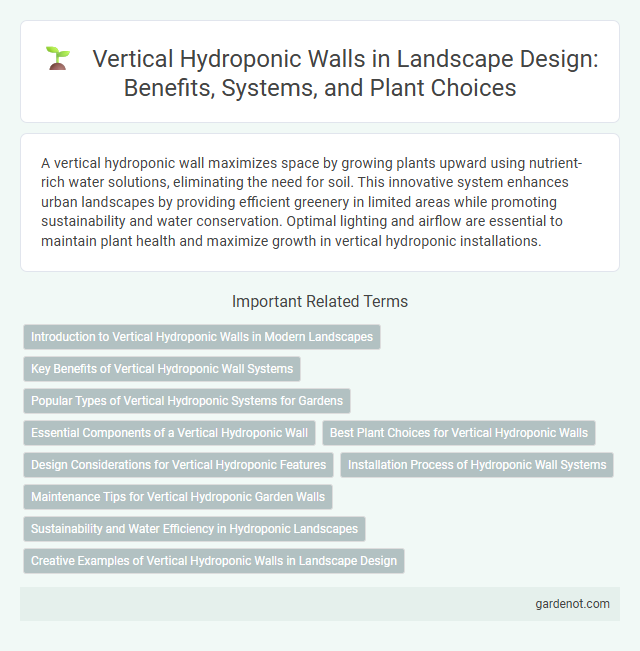A vertical hydroponic wall maximizes space by growing plants upward using nutrient-rich water solutions, eliminating the need for soil. This innovative system enhances urban landscapes by providing efficient greenery in limited areas while promoting sustainability and water conservation. Optimal lighting and airflow are essential to maintain plant health and maximize growth in vertical hydroponic installations.
Introduction to Vertical Hydroponic Walls in Modern Landscapes
Vertical hydroponic walls revolutionize modern landscaping by maximizing space efficiency and enhancing aesthetic appeal through soil-free, nutrient-rich water systems. These walls support diverse plant species, improving air quality and providing sustainable greenery in urban environments. Integration of automated irrigation and LED grow lights ensures optimal growth conditions, making vertical hydroponic walls a cutting-edge solution for eco-friendly architectural design.
Key Benefits of Vertical Hydroponic Wall Systems
Vertical hydroponic wall systems maximize space efficiency by allowing plants to grow upwards, ideal for urban and limited-space environments. These systems enhance water conservation by recirculating nutrient solutions, reducing water usage by up to 90% compared to traditional soil gardening. Improved crop yield and faster growth rates result from controlled nutrient delivery and optimized light exposure in vertical hydroponic setups.
Popular Types of Vertical Hydroponic Systems for Gardens
Vertical hydroponic walls include popular systems such as nutrient film technique (NFT), aeroponics, and drip systems, each designed to maximize space and optimize plant growth in confined garden areas. NFT vertical walls circulate a thin film of nutrient-rich water over plant roots, enhancing oxygen access and nutrient uptake for leafy greens and herbs. Aeroponic walls use mist to deliver nutrients directly to roots suspended in air, promoting rapid growth, while drip systems supply precise nutrient droplets to plants grown on vertical supports, ensuring efficient water use and minimal waste.
Essential Components of a Vertical Hydroponic Wall
Essential components of a vertical hydroponic wall include a sturdy frame, a water distribution system, and a nutrient delivery mechanism. The frame supports planting modules or pockets, while the water system ensures consistent irrigation and oxygenation of roots. Nutrient solutions rich in macro and micronutrients are circulated to optimize plant growth and health in a compact vertical space.
Best Plant Choices for Vertical Hydroponic Walls
Lettuce, spinach, and kale are ideal plants for vertical hydroponic walls due to their compact growth and high yield in controlled environments. Strawberries and herbs like basil, mint, and cilantro thrive exceptionally well on vertical structures, benefiting from efficient nutrient delivery and minimal root space requirements. Fast-growing microgreens also optimize space and provide quick harvest cycles, making them suitable for hydroponic vertical gardens.
Design Considerations for Vertical Hydroponic Features
Design considerations for vertical hydroponic walls include selecting lightweight, durable materials such as PVC or aluminum frames to support plant weight and water systems. Optimal spacing and orientation enhance light exposure and airflow, promoting healthy plant growth while preventing mold and disease. Integration of efficient irrigation and drainage systems is crucial to maintain consistent moisture levels and minimize water waste in vertical setups.
Installation Process of Hydroponic Wall Systems
Installing a vertical hydroponic wall system involves securely mounting the framework on a structurally sound surface, ensuring proper water and nutrient flow through integrated piping or tubing. Precise alignment of the planting modules or pockets is essential to maintain uniform irrigation and root aeration for optimal plant growth. Electrical components such as pumps and timers must be configured to automate the nutrient solution cycle, minimizing manual maintenance while promoting consistent hydroponic conditions.
Maintenance Tips for Vertical Hydroponic Garden Walls
Regular inspection of water flow and nutrient solution levels ensures optimal plant health in vertical hydroponic garden walls. Cleaning the system's pipes and reservoirs prevents algae buildup and clogs that can hinder growth. Monitoring plant roots and trimming excess growth supports efficient nutrient absorption and promotes a thriving hydroponic landscape.
Sustainability and Water Efficiency in Hydroponic Landscapes
Vertical hydroponic walls significantly enhance sustainability by reducing soil waste and minimizing land use in urban environments. These systems optimize water efficiency through recirculation techniques that lower consumption by up to 90% compared to traditional agriculture. Integration of smart sensors further ensures precise nutrient delivery, promoting healthy plant growth while conserving valuable water resources.
Creative Examples of Vertical Hydroponic Walls in Landscape Design
Vertical hydroponic walls transform urban landscapes by integrating innovative systems such as modular panels filled with nutrient-rich water, supporting lush plant growth without soil. Creative examples include living walls in office lobbies equipped with edible herbs, and large-scale installations in public parks featuring native plant species that enhance biodiversity while conserving space. These vertical gardens not only optimize limited urban areas but also improve air quality and create visually striking, sustainable environments.
Vertical hydroponic wall Infographic

 gardenot.com
gardenot.com